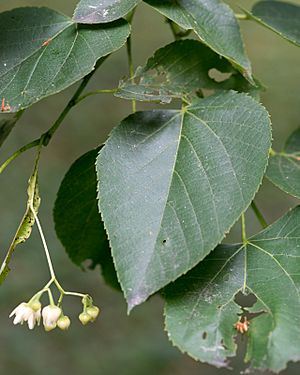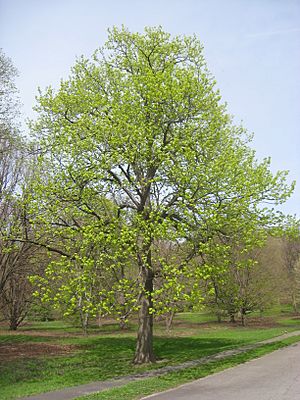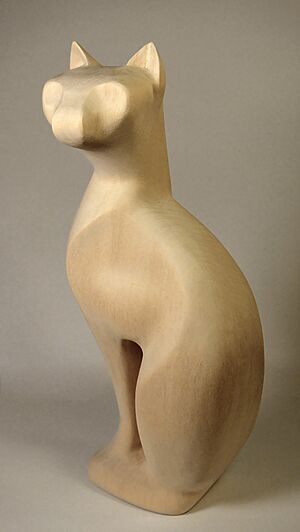American basswood facts for kids
Quick facts for kids American basswood |
|
|---|---|
 |
|
| Leaves and flowers | |
| Conservation status | |
| Scientific classification | |
| Genus: |
Tilia
|
| Species: |
americana
|
 |
|
| Natural range | |
| Synonyms | |
|
Tilia glabra Ventenat |
|
The Tilia americana, also known as American basswood or American linden, is a type of tree found in eastern North America. It grows from places like Manitoba in Canada all the way down to South Carolina in the United States. This tree is the only kind of Tilia (or linden) tree that naturally grows in North and South America.
Contents
What Does the American Basswood Look Like?

The American basswood is a medium to large deciduous tree, which means it loses its leaves every autumn. It can grow very tall, usually between 18 to 37 meters (about 60 to 120 feet) high. Its trunk can be 1 to 1.5 meters (about 3 to 5 feet) wide. This tree grows quite fast, often twice as fast as other North American trees like the American beech. It can live for about 200 years.
The top part of the tree, called the crown, is shaped like a dome with branches that spread out. The bark is gray to light brown and has narrow cracks. Its roots are big, deep, and spread out wide. The young branches, called twigs, are smooth and reddish-green.
The leaves are simple and grow one after another along the branch. They are often heart-shaped and uneven at the bottom, with one side being larger than the other. They are usually 10 to 15 centimeters (4 to 6 inches) long and wide, but can sometimes grow much bigger. When they first appear in spring, they are pale green and soft. As they grow, they become dark green and shiny on top, and lighter underneath. In autumn, the leaves turn yellow-green or yellow.
The flowers are small, yellowish-white, and smell nice. They grow in hanging bunches of 6 to 20 flowers. Each bunch has a special leaf-like part called a bract attached to it. These flowers are important for pollinators like bees. The tree usually flowers in late spring or early summer, depending on where it grows.
After the flowers, the tree produces small, round, dry, cream-colored nutlets. These are the fruit of the tree, about 8 to 10 millimeters (about 0.3 to 0.4 inches) wide.
Where Does the American Basswood Grow?
American basswood trees are often found in forests with sugar maple trees. These forests are common in places like western Wisconsin and central Minnesota. You can also find them in other types of forests, especially where the soil is moist and has a high pH (meaning it's not too acidic).
Animals and the Basswood Tree
The basswood tree is very important for many animals:
- Its flowers produce a lot of nectar, which is a sweet liquid that insects love.
- Chipmunks, mice, and squirrels eat the seeds.
- Rabbits and voles sometimes eat the bark of young trees.
- Many types of caterpillars eat the leaves. One special caterpillar, the ribbed cocoon maker (Bucculatrix improvisa), only eats basswood leaves.
- The tree can be affected by Japanese beetles, which are an invasive species in North America. These beetles like to eat its leaves.
How People Use American Basswood
People can grow American basswood trees from cuttings, by grafting (joining parts of two plants), or from seeds. These trees grow quickly in rich soil.
It can be tricky to grow basswood from seeds because many seeds are not able to sprout, and they quickly develop a very hard outer shell. If you want to plant them, it's best to collect the seeds in early autumn before they dry out. This way, they might sprout right away. However, the tree mostly spreads by growing new shoots from its stump if it's cut down.
The American basswood is a great tree for planting in yards or parks if you want a lot of shade or a big, leafy tree. It's also sometimes planted to protect younger, more delicate trees from the wind.
Both the leaves and flowers of the basswood tree can be eaten, especially the young, tender leaves. The flowers are also great for attracting pollinators. Bees make delicious honey from basswood blossoms that has a slightly spicy taste. In the past, people used the inner bark of the tree to make things like baskets, rope, and fishing nets because it's very strong and fibrous.
Basswood Wood
The wood of the American basswood is pale brown, sometimes almost white or with a hint of red. It is light, soft, and has a fine, smooth grain. It doesn't split easily and is good for carving. It's often used to make wooden items, furniture, and parts of wagons.
Basswood is also a popular wood for making the bodies of electric guitars. It's light, strong, and helps the guitar sound good. Because its grain isn't very noticeable, it's often used for guitars that will be painted a solid color. It's especially popular for guitars used in heavy metal music.
Medicinal Uses
People have also used American basswood for medicinal purposes. The dried flowers are a bit sweet and sticky.
- Linden tea, made from the flowers, tastes good because of the fragrant oils in the blossoms.
- The flowers, leaves, wood, and charcoal (made from the wood) have all been used as medicine.
- Linden flowers contain special compounds called flavonoids, which are like antioxidants that protect your body. They also have soothing substances that can help reduce swelling.
- Linden flowers are used for colds, coughs, fevers, and headaches.
- The leaves are used to help people sweat, which can reduce fevers.
- The wood has been used for problems with the liver and gallbladder.
- Charcoal made from the wood can be eaten to help with stomach issues or used on the skin for swelling or infections.
See also
 In Spanish: Tilo americano para niños
In Spanish: Tilo americano para niños




